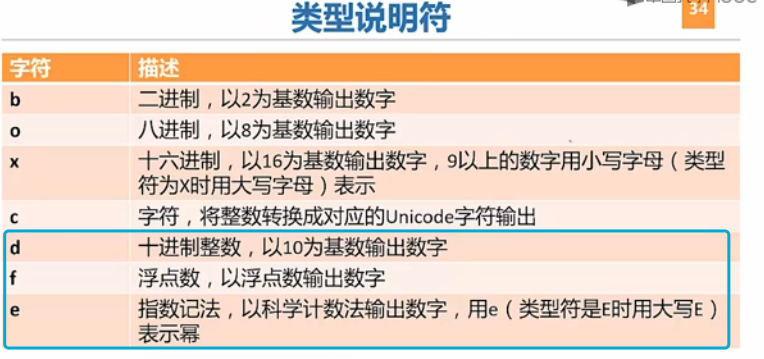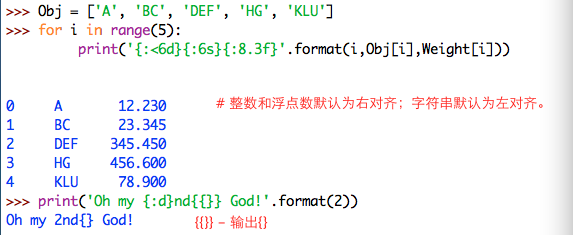博文
Python3: 格式化输出 print()
|||
参考: http://blog.csdn.net/lcore/article/details/9057967
print(...)
print(value, ..., sep=' ', end='n', file=sys.stdout, flush=False) # n表示换行
>>> name1 = 'Jane'
>>> name2 = 'Liz'
>>> num1 = 1
>>> num2 = 2
>>> print (name1 + ',' + name2)
Jane,Liz
>>> print (name1 + name2, sep='|' )
Jane|Liz
>>> print (name1, name2, num1, num2, sep=' -- ', end='...n')
Jane -- Liz -- 1 -- 2...
格式化输出
方法一:
print (format_string %(arguments_to_convert))
e.g. print ('There are %d punctuation marks.' %(count))
1. 输出整数。%d
>>> print ('Numbers are %d and %d' %(num1,num2))
Numbers are 1 and 2
2. 输出其他进制数。
%x --- hex 十六进制
%d --- dec 十进制
%o --- oct 八进制
3. 输出浮点数。 %f
>>> print ('%10.3f' % 3.1415926) # 整个输出为10列,保留3位小数位数(最后一位按四舍五入进位),默认右对齐,左边用7(10-3)个空格填充。
3.142
4. 输出字符串。 %s
>>> print ('Names are %s and %s' %(name1, name2))
Names are Jane and Liz
>>> print ('This is %.3s' %(name1))
This is Jan
>>> print ('That is %10.2s' %(name2)) # 整个输出为10列,变量从开始起截取的长度为2,默认右对齐,左边用8(10-2)个空格填充。
That is Li
方法二(适用于Python3):format函数
print (format_string.format(arguments_to_convert))
e.g. print('There are {0:d} punctuation marks.'.format(count) )
- {参数的序号:格式说明符}
参数的序号从0开始编号,可以不按顺序;若不声明(不写),则按照format函数第0,1,2...个参数的默认顺序。
格式说明符又叫格式限定符。



{0: <5d} - 第0个参数,左对齐,以十进制整数的方式输出,输出共占5列(填不满默认右边填充空格)。。
{1: 5.2f} - 第1个参数,默认右对齐,以浮点数的方式输出,保留2位小数位数,输出共占5列(填不满默认左边填充空格)。

https://blog.sciencenet.cn/blog-3031432-1058094.html
上一篇:Python3: 提示输入——input函数
下一篇:Emacs: 系列教程 & GNU Emacs Reference Card